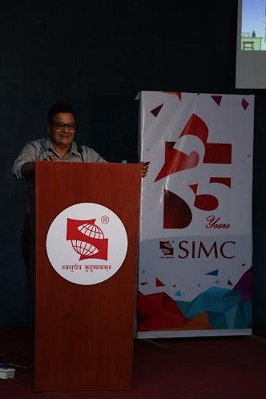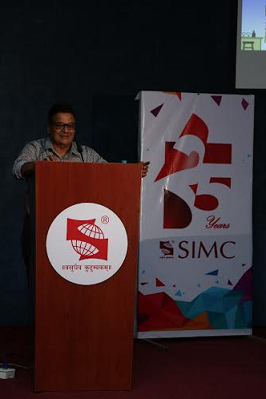
 Out-of-home advertising is an age-old advertising format assumed to be restricted to billboards and hoardings on roadsides that were seen as nothing but a nuisance and a distraction. Interestingly enough, with the advancement of technology, it is gaining importance in the field of advertising. With billboards now going digital and interactive and the integration of mobile phones into the OOH sphere, evolution comes as the next obvious step.
Out-of-home advertising is an age-old advertising format assumed to be restricted to billboards and hoardings on roadsides that were seen as nothing but a nuisance and a distraction. Interestingly enough, with the advancement of technology, it is gaining importance in the field of advertising. With billboards now going digital and interactive and the integration of mobile phones into the OOH sphere, evolution comes as the next obvious step.
On the 7th of August 2016, Symbiosis Institute of Media & Communication, Pune, hosted it’s annual Media Management as well as its first ever Research and Analytics Conclave, focusing on the theme “Agency of the Future”. Among the array of esteemed speakers, such as Kartik Sharma, Managing Director at Maxus; Sundeep Nagpal, Founder Director at Stratagem Media Pvt Ltd; Niteen Bhagwat, Executive Director and CEO at Asterii Analytics; Sarang Panchal, CEO at MRSS India; Mubin Khan, Head of Products, Research and Analytics, Senior VP at BARC, India, we had the honour of hosting Mr. Suresh Balakrishna, CEO India, Middle East and South Asia at Kinetic to answer a few questions for us based on the topic, “the state of out-of-home as a medium in India”.
Mr. Suresh Balakrishna joined Kinetic, part of the WPP Group, in January of this year, prior to which he worked at IPG MediaBrands as the CEO of Brand Programming Network (BPN) for four years. He played a significant role in bringing BPN to India and in helping MediaBrand’s OOH sector bloom across the country.
When asked whether the growth of smartphones and social media has hampered the attention given to billboards and hoardings, he countered that Kinetic was partnering very well with smartphones. In fact, they used that technology to improve the quality of the consumer experience. He said, “Whether it is the digital screens or the scanning of the screens, whatever we are doing, it is in collaboration with this and it is making out-of-home more interactive.” He stated the example of the Ford Mustang digital hoarding at Delhi airport, which actually gives out the sound of the Mustang engine in order to grab attention. The moment the digital screen is looked at, it blows out air, and the Mustang passes across the screen. This proves that technology helps better the consumer experience thus making it a win-win situation.
Enquiring whether enough attention was paid to the rural market in the OOH space and what the challenges were there, Mr. Balakrishna spoke about how out-of-home is one of the most impactful mediums in rural India. Due to low internet penetration and power cut induced limited television reach in rural India, OOH worked brilliantly. Small towns in rural India have bus stops where people congregate, have shop fronts and marketplaces where many out-of-home exercises like permanent billboards are done. Despite the quality of billboards being basic, they are more effective communication tools than most others with clients using OOH for rural reach in the Tier II and Tier III areas.
Bangalore city government bodies want to abolish billboards and hoardings. On being questioned about what would happen to OOH, he said that the country is undergoing a complete relook, state by state, depending on how much pressure it was under for revenues. Taking Delhi and Chennai as examples, he explained how after wiping out billboards, the governments were now opening tenders and granting permissions for hoardings with very clear specifications. “Earlier on, it was completely disorganised. They were constructed wherever permission was received and if it got permission for one, four were constructed. That used to be the kind of attitude. Now the government is actually doing a wonderful job of actually structuring that.” Mr Balakrishna was optimistic and said that the new billboards would now look much better, be of better quality and construction.
On being asked what the global practices Kinetic used to cater solely to the Indian market were, he informed us about the proprietary tools and measurement tools like the Social Amplification Score (SAS) and the CEE app that was generated in Kinetic Worldwide in the UK and US markets, the hubs of development. These tools are either imported directly to India or tweaked to suit the Indian context better. However, it was largely measurement, research and software that can help improve India’s present state.
Following the success of the “Silk Now Bubbled Up for Joy” campaign winning the Best Campaign of the Year award at the NEONS, we wondered what the thought process behind this innovation was. Mr Balakrishna expounded that in the brief, they were only told that the form of the chocolate was changing from flat to bubbled up and that the fun had to be conveyed. Thus, Kinetic decided to show the consumer in an interactive fun way that it was the same chocolate, just bubbled up. They used blow sensors, motion sensors and speed sensors to make it a complete success.
The Free Smokes campaign by Kinetic promotes experiential marketing. When asked about this, he replied that experiential or interactivity is brought in largely when a brand wants to bring alive the brand proposition to the consumer. Therefore, experiential marketing costs are slightly higher than that of any other medium as the cost per contact is more due to the better quality of the contact and social media helps it go viral. Due to this, agencies are making better returns because the margins in experiential and out-of-home are much better than a conventional media agency.
To conclude the interview, we asked him if there was any advice he would like to leave with us. Reminiscing about his time as an adjunct faculty at SIMC five years ago, he said the buzz about SIMC has increased and that people speak about it now that it is more visible. After the enlightening interview with Mr. Balakrishna, we were left feeling a little wiser.
